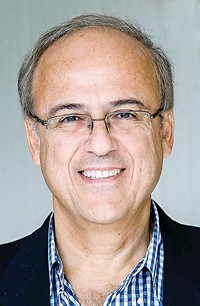Advertisement
Grab your lab coat. Let's get started
Welcome!
Welcome!
Create an account below to get 6 C&EN articles per month, receive newsletters and more - all free.
It seems this is your first time logging in online. Please enter the following information to continue.
As an ACS member you automatically get access to this site. All we need is few more details to create your reading experience.
Not you? Sign in with a different account.
Not you? Sign in with a different account.
ERROR 1
ERROR 1
ERROR 2
ERROR 2
ERROR 2
ERROR 2
ERROR 2
Password and Confirm password must match.
If you have an ACS member number, please enter it here so we can link this account to your membership. (optional)
ERROR 2
ACS values your privacy. By submitting your information, you are gaining access to C&EN and subscribing to our weekly newsletter. We use the information you provide to make your reading experience better, and we will never sell your data to third party members.
Environment
Greater Industry Innovation Urged
by Jeff Johnson
May 17, 2004
| A version of this story appeared in
Volume 82, Issue 20
Some 200 chemical research directors from government, industry, and academia came together last month to explore what role chemical R&D can play to help avoid an energy crisis that many believe is on the horizon and is likely to come with disastrous worldwide impact.
The conference was organized by the independent Council for Chemical Research (CCR), a 25-year-old organization created by a Dow Chemical vice president. Its role is to bring together a broad range of key U.S. scientists each year to recalibrate and coordinate a national chemical R&D agenda. This year, CCR's focus was on energy.
The discussion came at a difficult time for U.S. chemical companies, which are reeling from skyrocketing natural gas prices that have held profits in check. These concerns, along with the fear that growing competition from developing nations will only make matters worse for U.S. chemical producers, set the stage for the three-day energy conference.
While energy R&D was the conference topic, it soon became apparent that energy R&D cannot be pulled from the web of other issues that affect chemical production and research. Indeed, from the initial panel on, a tangle of energy-related issues pummeled attendees--from profits to new chemical products to the environment.
First off, several industry analysts pointedly said U.S. chemical companies' long-running advantage, gained from its use of once-inexpensive natural gas as feedstock and fuel, is over.
About 65% of U.S. chemical industry production is dependent upon natural gas, compared with Europe's 15% and Asia-Pacific's 10%, according to analysts' estimates. Consequently, U.S. industry faces a gas-driven energy problem of large dimensions and different from the rest of the world.
The feedstock cost advantage in traditional chemical products will likely shift to European and Asia-Pacific competitors, they said, which have looked more to oil-based feedstocks. U.S. natural gas is likely to remain several times more expensive than in previous years when compared with the price of oil.
Speakers predicted that worldwide demand for fossil fuel resources will grow, too. This will be led by China, India, and other developing nations, which will have increasing needs for oil, gas, and other fossil fuels for chemical production and energy.
Toss in the problem of global climate change, and the search for non-fossil-based alternative fuels and feedstocks becomes even more important, speakers said. But on global warming, this group was split, with some urging quicker action and others wanting more study before setting an agenda for action or a direction for research.
THE DISAGREEMENT on climate change did not dampen interest in alternative, biomass-based feedstocks and fuels.
But for a shift to alternative fuels to really work, more must be done than simply replace a fossil fuel with a nonfossil fuel, argued Avi Nash, who heads a management consulting firm that bears his name. The natural gas price problem, he said, is likely to be permanent, and, in the short term, cost-cutting efforts and technologically advanced process modifications are obviously necessary to improve profits. However, for the future, he urged much more R&D into new chemical products that will put U.S. chemical producers on a path to better profits.
The chemical industry has become stale, and, he said, few "megaproducts," worth $1 billion or more in annual sales, have been developed by the U.S. chemical industry in the past 30 years.
Other speakers hammered home the same point and sought to combine the drive for new products and profits with the need to address the energy crisis. They held up the example of DuPont's Sorona as a possible model of an alternative feedstock.
Sorona is a polypropylene terephthalate made from a 1,3-propanediol monomer, in turn synthesized from corn-derived glucose using a genetically engineered bacterium (C&EN, Oct. 21, 2002, page 14). Its market possibilities were stressed by Robert R. Dorsch, DuPont director of business development, when he described its benefits over traditional polyesters. Sorona, he said, is elastic, feels good to the touch, is easy to dye, holds its color well, and is a new product with great potential.
To be most profitable, biobased products such as Sorona are best made through manufacturing processes that also include biomass-based fuel production, several speakers said.
In other words, for a biobased future, chemical R&D must help develop high-value chemicals and manufacturing processes as well as fuel, said Donald B. Anthony, the council's president and executive director, in a postconference interview. He envisions biorefineries that manufacture new chemical products along with producing fuels, such as ethanol.
A biobased chemical industry, he said, should develop multiple products and use multiple feedstocks such as corn and other farm products as well as wood, municipal, and farm wastes.
"If biomass is just converted to fuel, it will not necessarily be effective or efficient use of that material," he said. Instead, he urged the manufacture of "unique and highly valuable chemical products" that increase a company's profitability as well as make fuel as a by-product.
"The model should be like a petrochemical refinery that takes a petroleum molecule and makes a slate of hundreds of products. It doesn't just take crude oil and turn it into gasoline," Anthony said.
Among other issues discussed during the conference was the Bush Administration's big push for a "hydrogen economy." This audience was divided on the possibility of hydrogen-based energy systems, as well as on when, or even if, the research community could overcome the technological impediments to making, storing, and using hydrogen for transportation or stationary fuel cells.
"Developing materials to store hydrogen at high densities and allow its rapid release is not a simple problem," Anthony added, "but there are real research opportunities out there."
Speaker after speaker stressed the need for more chemical energy R&D. Over the next few months, CCR members will put together their views on a framework for research opportunities that can be easily understood by Congress, government agencies, and industry, Anthony said.
The Council for Chemical Research (CCR) was formed in 1979 to encourage collaboration among chemical scientists and researchers working in academia, government, and industry.
The first council meeting was convened by Dow Chemical's vice president for research, Mac Pruitt, who was the driving force behind the organization. Today, CCR has about 200 members, including industry and government R&D managers, chairs of university chemistry departments, and other scientists in these sectors.
The organization is governed through four member "action networks" that try to encourage and direct research investments, stimulate collaborations, aid chemical graduate education, and continuously formulate long-range chemical research agendas.
CCR's leaders say that diversity in the chemical R&D sector, green chemistry, and sustainability of the world's resources are among its top long-range issues. Energy research will join these cardinal issues, CCR officials say.
The organization's strength is its access to top chemical researchers, says Esin Gulari, past CCR chairman and National Science Foundation director of the Division of Chemical & Transport Systems.
"We can delve into these issues in a nimble fashion," she says. "Global warming, energy shortages, and so forth are bigger issues than anyone can completely understand, and they all have significant chemical research elements. We need to team up to address them."
Sometimes the collaboration gets very direct, CCR President Donald B. Anthony says. "Our industry members," he says, "are often very interested in communicating to the chemical research community at large that these are the things they need.
"Companies often 'preannounce' before the meeting that they are interested in research in certain areas. We try to prearrange conversations between attendees, as well as set the agenda."
The Council for Chemical Research (CCR) was formed in 1979 to encourage collaboration among chemical scientists and researchers working in academia, government, and industry.
The first council meeting was convened by Dow Chemical's vice president for research, Mac Pruitt, who was the driving force behind the organization. Today, CCR has about 200 members, including industry and government R&D managers, chairs of university chemistry departments, and other scientists in these sectors.
CCR's leaders say that diversity in the chemical R&D sector, green chemistry, and sustainability of the world's resources are among its top long-range issues. Energy research will join these cardinal issues, CCR officials say.
The organization's strength is its access to top chemical researchers, says Esin Gulari, past CCR chairman and National Science Foundation director of the Division of Chemical & Transport Systems.
"We can delve into these issues in a nimble fashion," she says. "Global warming, energy shortages, and so forth are bigger issues than anyone can completely understand, and they all have significant chemical research elements. We need to team up to address them."
Sometimes the collaboration gets very direct, CCR President Donald B. Anthony says. "Our industry members," he says, "are often very interested in communicating to the chemical research community at large that these are the things they need.
"Companies often 'preannounce' before the meeting that they are interested in research in certain areas. We try to prearrange conversations between attendees, as well as set the agenda."







Join the conversation
Contact the reporter
Submit a Letter to the Editor for publication
Engage with us on Twitter